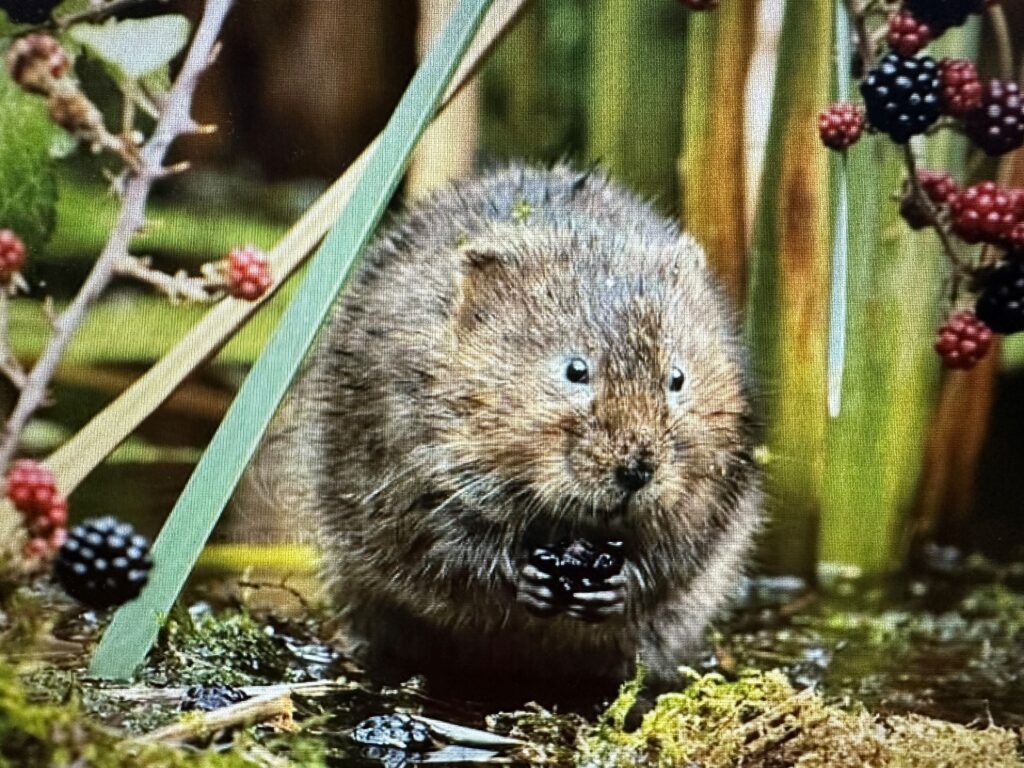Busy on the banks of our canals and rivers the water vole is generally on the move, finding and eating vegetation, nibbling it at almost exactly 45 degrees, patrolling its territory and tunnelling, with its teeth, into soft banks to make their homes – but sometimes they are to be found at the mouth of their burrows having a snack from the little ‘lawn’ they have created out in front.
An idyllic pastural scene and a rosy picture that many of us like to think of but, in reality, their fate has been very much in the hands of man as changes in river management, agricultural techniques and, not forgetting, the freeing of many mink from fur-farms in the 1970s – which turned out to be a disaster for the water vole population, and is a fine example of unexpected consequences – their population has seen a massive drop of some eighty percent and in some areas they are all but extinct! This makes them the most endangered mammal species in Britain.
Jenny Spelling, an ecologist with Canal & River Trust (CRT), covering much of the Montgomery, Shropshire Union and part of the Trent and Mersey canals, painted a positive picture when she said, “Work to encourage these charming little creatures back to the canals is so very important as they are an integral part of our ecosystem, and their burrowing, feeding, and hiding places provide the conditions for other animal and plant life to flourish, and we are making good, if a little slow, progress. There have been several focused projects, one being the Green Recovery Challenge Fund with money from the Heritage Lottery which was a fund set up to kick start environmental renewal and was taken advantage of by CRT as they targeted suitable, mink free areas to create habitat. When I say, ‘mink free’ I mean areas where there has been no evidence or sightings of mink – it can’t be a precise science. There are already thriving colonies in Whitchurch, Shropshire and where the Montgomery joins the Llangollen canal at Frankton Junction”.
During the restoration of any canal there is much time, energy and money spent on mitigating for all species of plant and animal that may be affected by the work. The Montgomery Canal is no exception with the three Aston Nature reserves, a good example of created habitat on a reasonably grand scale. The restoration itself can also offers up opportunities for new habitats on the line of canal itself.
Jenny continued, “The Montgomery canal is at a very exciting stage, just south of Crickheath Bridge, as the Shropshire Union Canal Society, the restoration contractors for CRT, have the chance to build tailor-made water vole habitat. Tom Fulda, the project manager, and his team are working with myself, another Ecologist, Glyn Stewart, and CRT on the design so the conditions that will attract water voles will be a part of the built structure and hopefully we will see results in the next couple of years”.
So, let’s hope that in the not-too-distant future, water voles will be attracted by the possibilities of life on the Monty, and we can, once again, hear the rustle and plop as these wonderful little fellows go about their busy lives.





Pictures:
1 Swimming home Chloe Walker
2 Vole 1 with blackberries Nick Robert Lay
3 Vole 2 with apple Nick Robert Lay
4 Vole 3 looking to the future Nick Robert Lay
5 Vole 4 just thinking Nick Robert Lay







